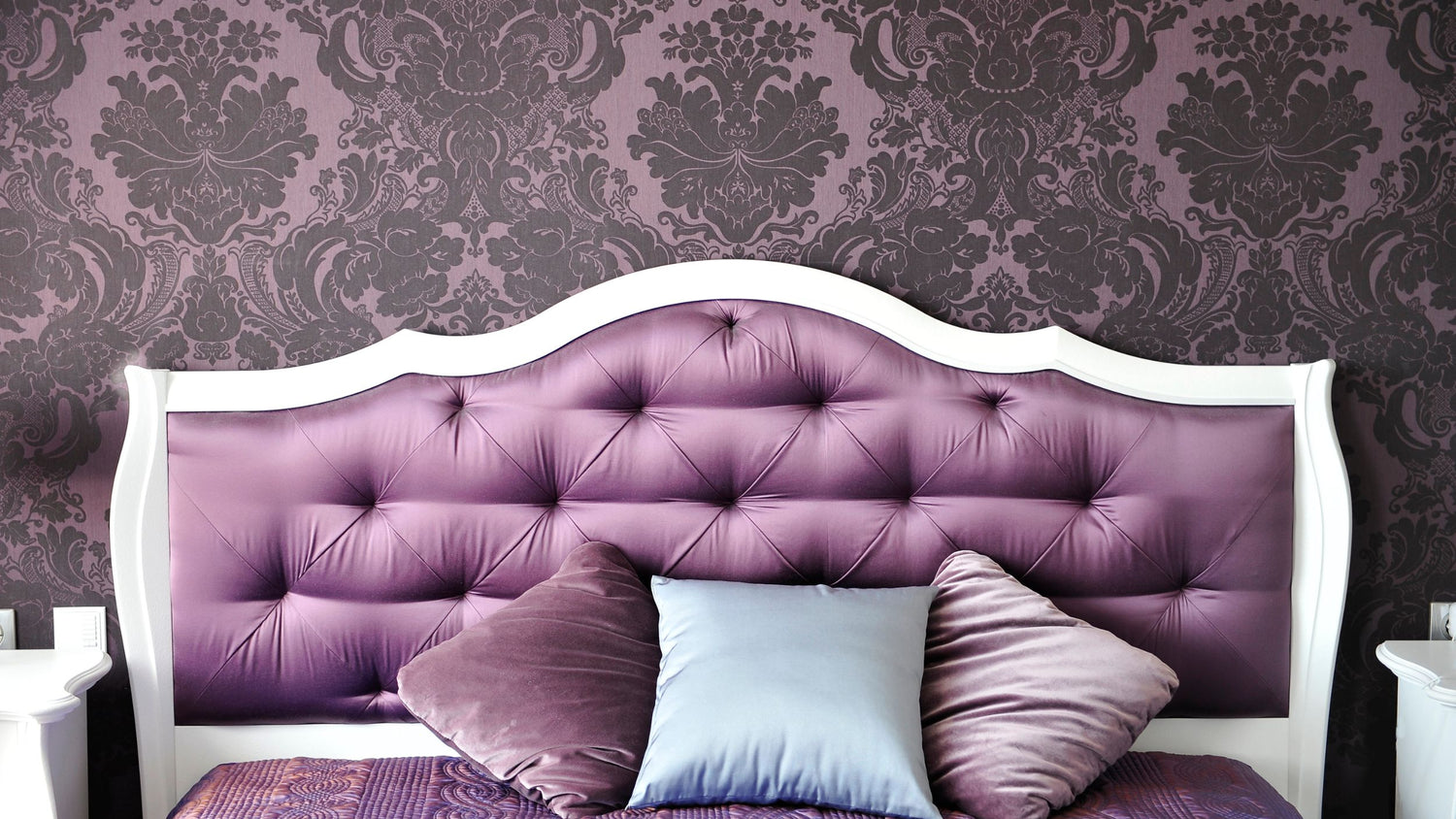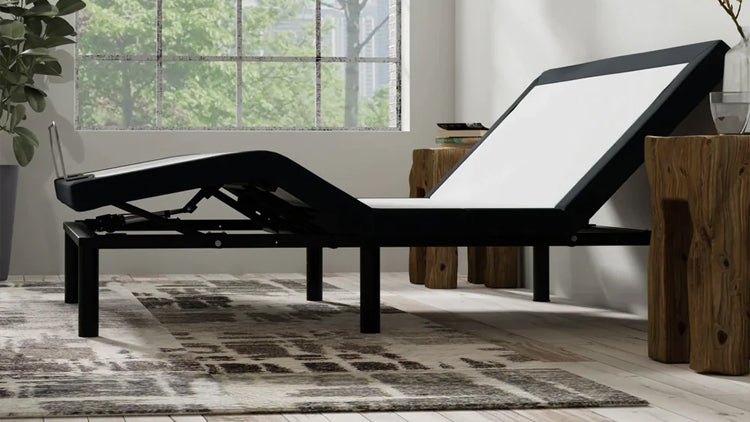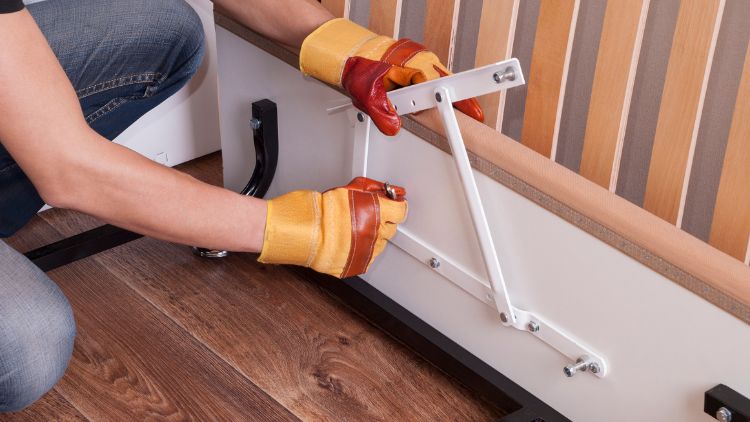Upholstering a headboard can add a touch of luxury and personal style to your sleeping space. It doesn't have to be complicated or costly, and you don't need fancy sewing or carpentry skills. This step-by-step guide will show you how to upholster a headboard easily and effectively.
What You'll Need
Before you begin, gather the following tools and supplies:
Tools:
- Utility knife
- Staple gun
- Fabric shears
- Measuring tape
- French cleat, screws, screwdriver or drill (if needed for hanging)
Supplies:
- Staples
- Spray adhesive or carpet tape
- Fabric
- Furniture foam
- Batting (optional)
- Wooden headboard or MDF/plywood board (if not reupholstering)
- Jigsaw (if rounding the edges of plywood)
- Nailhead trim, rubber mallet, marker, nailhead spacer (optional)
Now that you have everything you need, let's dive into the steps.

7 Steps to Upholster a Headboard
Step 1: Disassemble or Cut Your Headboard
If your bed has a headboard, it's easy to upgrade it. Take it apart and remove the old fabric. If it has side rails and a footboard, use a screwdriver to separate them.
If you don't have a headboard or are unsuitable, buy a 3/4-inch MDF or plywood board. The hardware store can cut it for you. Measure the height and width you want before going—usually, headboards are about 32 inches tall. For width, add 20 inches to your bed length for extra style.
Use a jigsaw to round the corners of the board to soften the edges.
Step 2: Cut Upholstery Foam and Cover the Board
Consider adding a layer of upholstery foam to achieve a plush and cozy headboard. If you're revamping an existing headboard, it might already have a usable foam layer. However, if it's worn out or flat or working from scratch with a plain board, you'll need to purchase some foam.
Begin by placing the board flat on the floor and then laying the foam on top, cutting it to match the board's shape using a utility knife.
Options include using double-sided carpet tape or a fast-drying adhesive spray to secure the foam. Another method involves cutting the foam slightly larger than the board and stapling the excess to the back of the frame with a staple gun. Be cautious not to cover potential screw holes during this process.
A safety reminder: When using adhesive spray, ensure proper ventilation, wear a mask, and keep pets and children away, as inhalation can pose risks.
Step 3: Add Batting
Batting offers a softer, padded feel than upholstery foam, though it's not as thick. If you desire a moderate level of cushioning without the extremely plush sensation of foam, consider using a layer or two of batting. Alternatively, apply batting over the upholstery foam for an extra plush outcome. An added benefit: Batting allows for easier creation of soft, curved edges, which can be shaped smoothly around corners.
To achieve these softer edges, ensure you cut an extra 5 to 8 inches of batting around the entire frame to fold it over to the back.
Pull the batting firmly and secure it by stapling it to the back of the frame. Staples should be placed approximately 1 inch away from the edges to maintain a seamless appearance. A helpful tip: Start stapling on one side first and then proceed to the opposite side to prevent wrinkling or bunching.
Step 4: Cut and Wrap the Fabric
The fabric required will vary based on your headboard's dimensions, typically 2 to 3 yards. Use shears to cut the fabric, leaving an allowance of approximately 5 inches to fold over all edges.
For a smooth, wrinkle-free appearance, iron the fabric. If the fabric features a pattern that requires centering, take your time to position it accurately.

Step 5: Staple Fabric in Place
Keeping the fabric tight is essential for a smooth finish, but don't pull it too hard, or it might wrinkle.
Use staples near the edges, first on one side and then the other. Place plenty of staples to ensure it stays put. Be careful with the corners and fold them neatly to keep things tidy.
Step 6: Add Optional Finishing Details
It's time to add your personal touch! Consider using furniture nails or nailhead trim along the edges. Use a ruler to guide you for a consistent look, keeping the nails approximately 1 to 3 inches from the edge and evenly spaced apart. To simplify the process, mark or use a nailhead spacer tool to indicate where each nail goes.
If you prefer an easier method, go for nailhead trim instead. With this, you'll only need to secure every fifth nail along the long trim, reducing the number of individual nails to tap in.
Step 7: Reassemble or Hang Your Headboard
You're all set to hang your newly upholstered headboard! If it's a new addition, secure it properly using metal French cleats—they're excellent for holding weight securely. One part attaches to the wall stud, and the other to the headboard.
Use a level to make sure the headboard hangs straight. Position it slightly below the mattress top for a seamless floor-to-ceiling look.
Now, enjoy your refreshed sleeping space to the fullest!
Remember, while this guide provides a general guide, specific steps still depend on the headboard type and materials used. Always refer to the instructions provided with your tools and supplies for any additional guidelines.
Upholstering a Headboard FAQs
What are the benefits of a tall upholstered headboard?
A tall upholstered headboard adds a touch of luxury and comfort to your bed. It provides excellent support while sitting in bed, acts as a statement piece, and offers extra insulation and warmth to your sleeping area.
What distinguishes a platform bed with an upholstered headboard?
A platform bed with upholstered headboard typically features a low-profile base with wooden slats to support the mattress. The upholstered headboard offers added comfort for sitting up while maintaining a sleek, modern look for the bed.
Are upholstered headboards easy to clean?
Cleaning methods depend on the material. Most fabric headboards can be spot-cleaned or vacuumed, while leather or faux leather may require specific cleaners.
Which materials do people commonly use for upholstered headboards?
Various materials like fabric (linen, velvet, cotton), leather, faux leather, and suede make upholstered headboards.
Do upholstered headboards come in different sizes?
Yes, upholstered headboards are available in various sizes to accommodate twin, full, queen, king, and even custom bed sizes.





Leave a comment
This site is protected by hCaptcha and the hCaptcha Privacy Policy and Terms of Service apply.